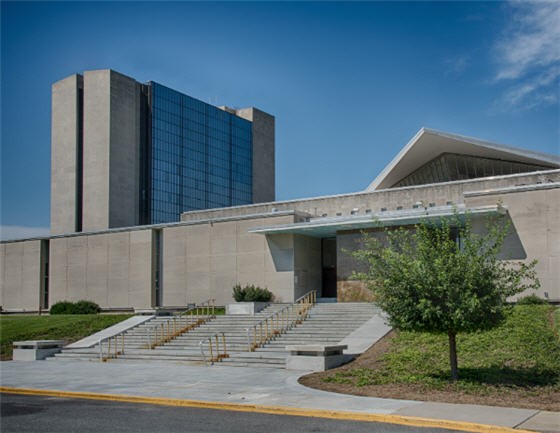National Library of Medicine
Introduction
Text-to-speech Audio
Images
National Library of Medicine (no copyright restriction on US Government works)

A Totem for Healing by Allen C. Browne on HMDB.org (reproduced under Fair Use)

Backstory and Context
Text-to-speech Audio
In 1956, an act of Congress transferred the Army Medical Library to the Public Health Service and renamed it the National Library of Medicine. Chief supporters of this transfer were Alabama Senator J. Lister Hill and Massachusetts Senator John F. Kennedy, under whose future presidency the National Library of Medicine would move to its current building in 1962.
The Bethesda campus of the National Institutes of Health, largely donated by the Wilsons of the Tree Tops estate, became the home of the new National Library of Medicine building. Its architecture demonstrates the anxieties of military threats during the Cold War; its key features are foot-think limestone walls, a collapsible roof, and underground book storage. The library became a hub for medical information technology with the establishment of the Lister Hill National Center for Biomedical Communications in 1968, MEDLINE in the 1970s (with a free service beginning in 1997), and the National Center for Biotechnology Information in 1988. In 2000, both ClinicalTrials.gov and PubMed Central opened.
Two reading rooms are open to the public in the library: the Main Reading Room and History of Medicine Division Reading Room. Visitors can access reference materials and request books, serials, audiovisual materials, pamphlets, and dissertations.
As part of the library's bicentennial celebration in 1976, it planted a garden of healing herbs and other plants. Thomas Cook, Chief of the NIH Grounds Maintenance and Landscaping Section, directed the planting. The layout of the garden echoes the layout of the library. Over 100 different plants now grow in the garden. Standing in the garden is A Totem of Healing, carved by Jewell Praying Wolf James of the Lummi Nation from a 500-year-old Pacific Red Cedar tree. The tree fell naturally in the state of Washington. A cross-section of the tree also resides in the library. The totem depicts a series of symbols, including a healing woman gathering herbs, a tree of life, and the Algonquian figure of the medicine woman in the moon.
Sources
Browne, Allen C. A Totem for Healing, Historical Marker Database. September 21st 2020. Accessed February 26th 2020. https://www.hmdb.org/m.asp?m=77836.
National Library of Medicine. A Brief History of NLM, March 20th 2019. Accessed February 26th 2020. https://www.nlm.nih.gov/about/briefhistory.html.
National Library of Medicine. NLM Herb Garden, About the NLM. February 23rd 2019. Accessed February 28th 2020. https://www.nlm.nih.gov/about/herbgarden/index.html.
National Library of Medicine. NLM Reading Rooms, Services, and Hours, About the NLM. November 6th 2019. Accessed February 28th 2020. https://www.nlm.nih.gov/readingroom/index.html.
https://www.nlm.nih.gov/about/briefhistory.html
https://www.hmdb.org/PhotoFullSize.asp?PhotoID=288427
